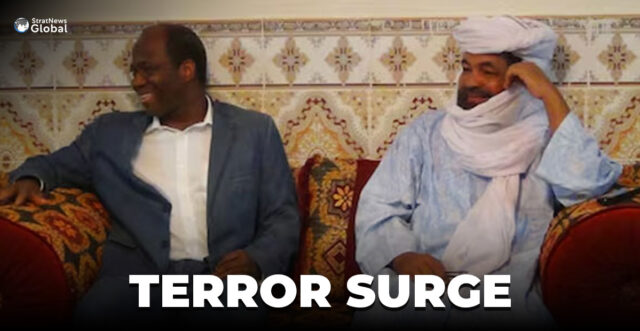At dawn on June 1, gunfire pierced the calm at Mali’s Boulkessi military base as waves of al-Qaeda-linked jihadists launched a surprise attack, catching newly deployed soldiers off guard.
Some troops, unfamiliar with the base, which lies near Mali’s southern border with Burkina Faso, scrambled to find cover while others fled into the arid brush, according to one soldier, who spoke to survivors of the attack.
The soldier, who had completed a tour at the camp a week before, requested anonymity because he was not authorised to speak to journalists.
JNIM Claims Victory
Hours after the attack, videos circulated online showing jubilant fighters from Jama’at Nusrat al-Islam wal-Muslimin (JNIM), stepping over the bodies of fallen soldiers.
JNIM claimed it had killed more than 100 troops and showed around 20 soldiers who said they were captured at the base. Reuters was unable to verify the claims independently.
The Boulkessi assault was one of more than a dozen deadly attacks by JNIM on military outposts and towns across Mali, Burkina Faso, and Niger in May and June. The insurgents claimed to have killed more than 400 soldiers in those attacks. Mali’s military government has not commented on the toll.
Reuters spoke to five analysts, a security expert and a community leader in the region who said the surge in violence reflects a strategic shift by JNIM – a group founded by a veteran Islamist who rose to prominence by briefly seizing northern Mali in 2012.
JNIM is moving from rural guerrilla tactics to a campaign aimed at controlling territory around urban centres and asserting political dominance in the Sahel, they said.
“The recent attacks point a concrete effort to encircle Sahelian capitals, aiming for a parallel state stretching from western Mali to southern Niger and northern Benin,” said Mucahid Durmaz, senior Africa analyst at risk intelligence group Verisk Maplecroft.
Massive Casualties
Attacks by JNIM left more than 850 people dead across Mali, Burkina Faso, and Niger in May, a rise from the average rate of killings of around 600 in previous months, according to data from U.S. crisis-monitoring group Armed Conflict Location & Event Data (ACLED).
The surge in attacks in May and June marks one of the deadliest periods in the Sahel’s recent history and underscores the threat posed by jihadist groups at a time when regional governments are estranged from former Western military allies, analysts say.
More than a decade of insurgencies in the Sahel has caused mass displacement and economic collapse. The violence has steadily spread towards coastal West Africa, straining regional stability and fuelling migration toward Europe.
On July 1, JNIM carried out simultaneous attacks on army camps and positions in seven towns in central and western Mali, according to an army statement and claims by the insurgents.
The army said 80 militants were killed. Reuters was unable to reach JNIM for comment. The group releases its statements and videos on social media and has no media spokesperson.
Mali’s army did not respond to Reuters requests for comments about the wave of JNIM attacks. It said in a statement after the Boulkessi assault that troops responded “vigorously” before retreating.
“Many soldiers fought, some to their last breath,” the statement said.
Strategic Pivot
JNIM’s leader, Iyad Ag Ghaly, has been instrumental in its transformation.
A former rebel leader in Mali’s Tuareg uprisings in the 1990s, Ag Ghaly led the fundamentalist group Ansar Dine that was part of a coalition of groups that briefly occupied northern Mali in 2012.
The militants imposed a harsh version of sharia law – banning music, imposing mutilations as punishment for crimes, and holding public executions and floggings.
Thousands fled, and cultural sites were destroyed, leaving lasting trauma in the region before the rebels were driven out by a French military intervention the following year. Ag Ghaly is wanted by the International Criminal Court for war crimes and crimes against humanity.
The military leaders in Mali, Burkina Faso and Niger, who seized power between 2020 and 2023 on the back of the prolonged insurgencies, promise to restore security before returning their countries to democratic rule.
They’ve cut ties with Western nations and expelled their forces, blaming them for failing to end the insurgencies and turning instead to Russia for military support.
After deploying mercenaries, the Russians have also suffered setbacks and been unable to contain the uprisings.
Burkina Faso
In Burkina Faso — a country about half the size of France — militants exert influence or control over an estimated 60% of the territory, according to ACLED.
Ag Ghaly, who has pledged allegiance to al-Qaeda, has positioned himself as the leader of a jihadist coalition that includes al-Qaeda in the Islamic Maghreb (AQIM), Al-Mourabitoun, and Katiba Macina after they merged into JNIM in 2017.
A Western security source, who requested anonymity because he is not authorised to speak publicly, told Reuters that JNIM has emerged as the region’s strongest militant group, with an estimated 6,000 to 7,000 fighters.
Ag Ghaly’s goal, the analysts said, is to impose Islamic rule across the Sahel and extend its influence to coastal West Africa, a region twice the size of Western Europe, with a population of around 430 million people, many of them Christian.
In a rare video released in December 2023, he denounced the military governments in Mali, Niger, and Burkina Faso and called on Muslims to mobilise against them and their Russian allies.
Ag Ghaly could not be reached for comment. The governments of Mali, Burkina Faso and Niger did not respond to requests for comment.
($1 = 554.9000 CFA francs)
(With inputs from Reuters)





